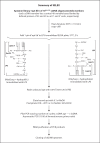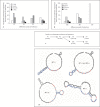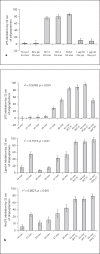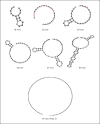Single-stranded DNA oligoaptamers: molecular recognition and LPS antagonism are length- and secondary structure-dependent
- PMID: 20375565
- PMCID: PMC7312852
- DOI: 10.1159/000145542
Single-stranded DNA oligoaptamers: molecular recognition and LPS antagonism are length- and secondary structure-dependent
Abstract
In Gram-negative bacterial infection, lipopolysaccharide (LPS) readily overwhelms the host innate immune system, which could result in inflammation and sepsis in severe cases. Therefore, developing anti-LPS molecules would confer an efficient antibacterial strategy. We used SELEX (Systemic Evolution of Ligands by EXponential enrichment) to isolate single-stranded DNA (ssDNA) aptamers. By immobilizing and exposing different orientations of the LPS molecule on hydrophobic and hydrophilic surfaces, two populations of aptamers were captured from a library of 10(14-15) ssDNA oligonucleotides. Progressive SELEX enriched the aptamers towards thymidine residues. The more hydrophobic aptamers with T-rich loops showed strong molecular recognition for the lipid A moiety of LPS, binding at affinity of up to K(D) of 10(-9)M, and eliciting 95% neutralization of endotoxicity. The longer ssDNAs exhibited greater avidity for LPS and conferred more efficacious antagonism against LPS. The nucleotide composition imposes subtle influence on the aptamer folding and affinity for LPS.
Copyright 2008 S. Karger AG, Basel.
Figures







Similar articles
-
Selection of a DNA aptamer that binds 8-OHdG using GMP-agarose.Bioorg Med Chem Lett. 2009 Jul 1;19(13):3619-22. doi: 10.1016/j.bmcl.2009.04.130. Epub 2009 May 3. Bioorg Med Chem Lett. 2009. PMID: 19450981
-
A novel lipopolysaccharide-antagonizing aptamer protects mice against endotoxemia.Biochem Biophys Res Commun. 2009 Apr 24;382(1):140-4. doi: 10.1016/j.bbrc.2009.02.152. Epub 2009 Mar 3. Biochem Biophys Res Commun. 2009. PMID: 19265672
-
Selection of DNA aptamers that bind to four organophosphorus pesticides.Biotechnol Lett. 2012 May;34(5):869-74. doi: 10.1007/s10529-012-0850-6. Epub 2012 Jan 20. Biotechnol Lett. 2012. PMID: 22261866
-
Recent Progress in the Identification of Aptamers Against Bacterial Origins and Their Diagnostic Applications.Int J Mol Sci. 2020 Jul 18;21(14):5074. doi: 10.3390/ijms21145074. Int J Mol Sci. 2020. PMID: 32708376 Free PMC article. Review.
-
Single-stranded DNA (ssDNA) production in DNA aptamer generation.Analyst. 2012 Mar 21;137(6):1307-15. doi: 10.1039/c2an15905h. Epub 2012 Feb 7. Analyst. 2012. PMID: 22314701 Review.
Cited by
-
Therapeutic Applications of Aptamers.Int J Mol Sci. 2024 Jun 19;25(12):6742. doi: 10.3390/ijms25126742. Int J Mol Sci. 2024. PMID: 38928448 Free PMC article. Review.
-
A New Insight into Phage Combination Therapeutic Approaches Against Drug-Resistant Mixed Bacterial Infections.Phage (New Rochelle). 2024 Dec 18;5(4):203-222. doi: 10.1089/phage.2024.0011. eCollection 2024 Dec. Phage (New Rochelle). 2024. PMID: 40045937 Review.
-
Aptamer against Aflatoxin B1 Obtained by SELEX and Applied in Detection.Biosensors (Basel). 2022 Oct 9;12(10):848. doi: 10.3390/bios12100848. Biosensors (Basel). 2022. PMID: 36290985 Free PMC article.
-
Beneficial Effects of Inflammatory Cytokine-Targeting Aptamers in an Animal Model of Chronic Prostatitis.Int J Mol Sci. 2020 May 31;21(11):3953. doi: 10.3390/ijms21113953. Int J Mol Sci. 2020. PMID: 32486412 Free PMC article.
-
2'-Fluoro-Pyrimidine-Modified RNA Aptamers Specific for Lipopolysaccharide Binding Protein (LBP).Int J Mol Sci. 2018 Dec 5;19(12):3883. doi: 10.3390/ijms19123883. Int J Mol Sci. 2018. PMID: 30563044 Free PMC article.
References
-
- Downey JS, Han J. Cellular activation mechanisms in septic shock. Front Biosci. 1998;3:d468–d476. - PubMed
-
- Tall A. Plasma lipid transfer proteins. Annu Rev Biochem. 1995;64:235–257. - PubMed
-
- Brun-Buisson C, Doyon F, Carlet J, Dellamonica P, Gouin F, Lepoutre A, Mercier JC, Offenstadt G, Regnier B. Incidence, risk factors, and outcome of severe sepsis and septic shock in adults. A multicenter prospective study in intensive care units. French ICU Group for Severe Sepsis. JAMA. 1995;274:968–974. - PubMed
-
- Lamping N, Hoess A, Yu B, Park TC, Kirschning CJ, Pfeil D, Reuter D, Wright SD, Herrmann F, Schumann RR. Effects of site-directed mutagenesis of basic residues (Arg 94, Lys 95, Lys 99) of lipopolysaccharide (LPS)-binding protein on binding and transfer of LPS and subsequent immune cell activation. J Immunol. 1996;157:4648–4656. - PubMed
-
- Schumann RR, Leong SR, Flaggs GW, Gray PW, Wright SD, Mathison JC, Tobias PS, Ulevitch RJ. Structure and function of lipopolysaccharide binding protein. Science. 1990;249:1429–1431. - PubMed
Publication types
MeSH terms
Substances
LinkOut - more resources
Full Text Sources
Other Literature Sources

